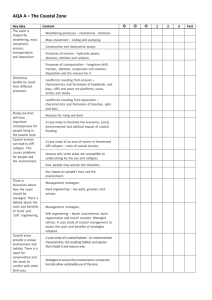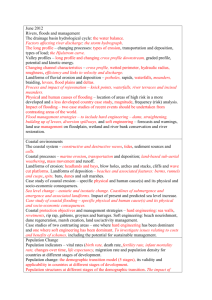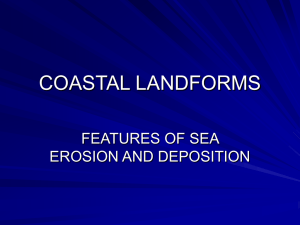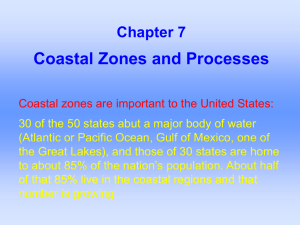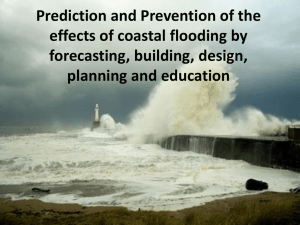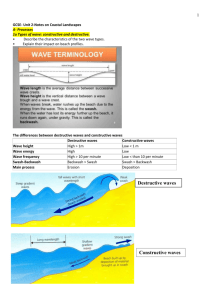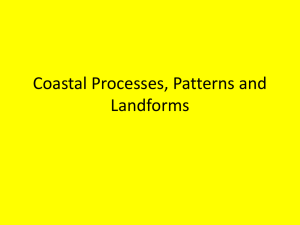Topic 5 – Coastal Change and Conflict
advertisement
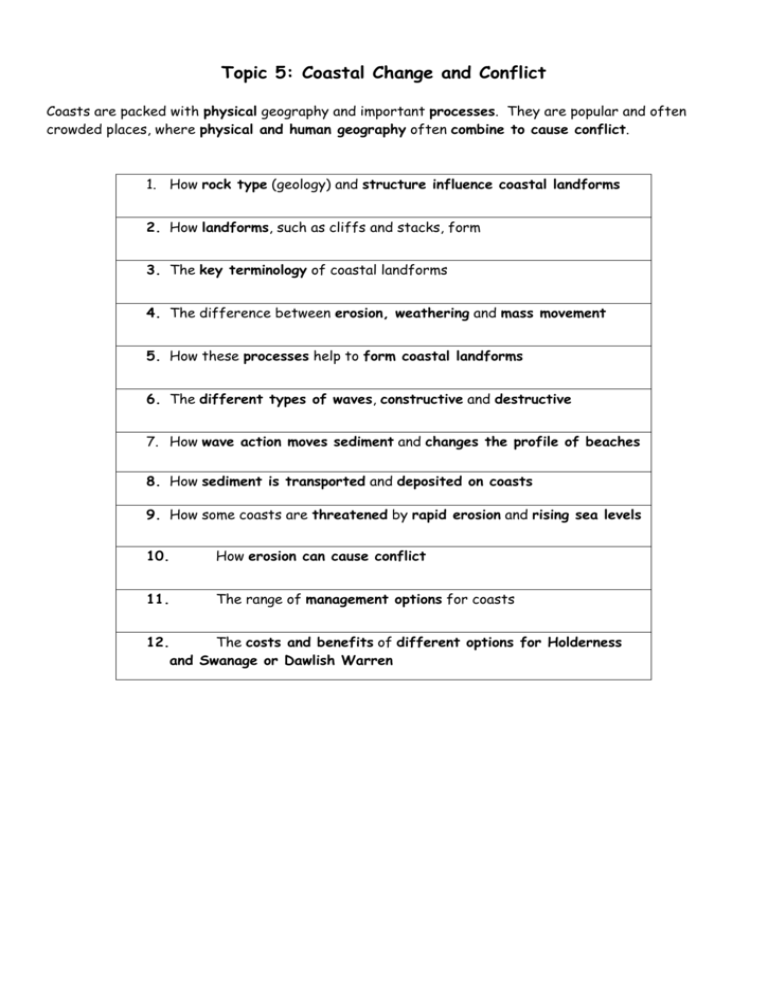
Topic 5: Coastal Change and Conflict Coasts are packed with physical geography and important processes. They are popular and often crowded places, where physical and human geography often combine to cause conflict. 1. How rock type (geology) and structure influence coastal landforms 2. How landforms, such as cliffs and stacks, form 3. The key terminology of coastal landforms 4. The difference between erosion, weathering and mass movement 5. How these processes help to form coastal landforms 6. The different types of waves, constructive and destructive 7. How wave action moves sediment and changes the profile of beaches 8. How sediment is transported and deposited on coasts 9. How some coasts are threatened by rapid erosion and rising sea levels 10. How erosion can cause conflict 11. The range of management options for coasts 12. The costs and benefits of different options for Holderness and Swanage or Dawlish Warren 1. How rock type (geology) and structure influence coastal landforms 2. How landforms, such as cliffs and stacks, form 3. The key terminology of coastal landforms 4. The difference between erosion, weathering and mass movement 5. How these processes help to form coastal landforms Hard and Soft Rocks Discordant Coastline: e.g Swanage Discordant - Geology is Perpendicular to the Coastline. Headlands are formed when the sea attacks a section of coast with alternating bands of hard and soft rock. The bands of soft rock, such as sand and clay, erode more quickly than those of more resistant rock, such as chalk. This leaves a section of land jutting out into the sea called a headland. The areas where the soft rock has eroded away, next to the headland, are called bays Concordant Coastline: e.g. Lulworth Cove Concordant - Geology is Parallel to the Coastline. A concordant coastline has the same type of rock along the coastline. Concordant coastlines tend to have fewer bays and headlands. Erosion Processes: (the wearing away of rocks) CASH!!! These processes take place at the foot of the cliff Corasion/Abrasion. Bits of rock and sand in waves grind down cliff surfaces like sandpaper. Attrition. Waves smash rocks and pebbles on the shore into each other, and they break and become smoother. Solution. Acids contained in sea water will dissolve some types of rock such as chalk or limestone. Hydraulic action. Air may become trapped in joints and cracks on a cliff face. When a wave breaks, the trapped air is compressed which weakens the cliff and causes erosion. Formation of Old Harry: Caves occur when waves force their way into cracks in the cliff face. The water contains sand and other materials that grind away at the rock until the cracks become a cave. Hydraulic action is the predominant process. If the cave is formed in a headland, it may eventually break through to the other side forming an arch. The arch will gradually become bigger until it can no longer support the top of the arch. When the arch collapses, it leaves the headland on one side and a stack (a tall column of rock) on the other. The stack will be attacked at the base in the same way that a wave cut notch is formed. This weakens the structure and it will eventually collapse to form a stump. One of the best examples in Britain is Old Harry Rocks, a stack found off a headland in the Isle of Purbeck. Cliff Retreat 1. Weather weakens the top of the cliff. 2. The sea attacks the base of the cliff forming a wave-cut notch. 3. The notch increases in size causing the cliff to collapse. 4. The backwash carries the rubble towards the sea forming a wave-cut platform. 5. The process repeats and the cliff continues to retreat. Task: Explain why some cliffs erode more rapidly than others (6 marks) Weathering: the breakdown of Rocks 1. Mechanical: (salt crystals) 2. Chemical: (acids) 3. Biological: (roots) Sub-aerial processes are the disintegration of rock through processes of weathering (such as freeze-thaw and thermal expansion) and the impact of wind and rain Sub-aerial processes happen on the Cliff FACE Mass Movement: Slumping Cliff 6. The different types of waves, Constructive and Destructive Constructive Waves: The effects of a low wave constructive waves are created in calm weather and are less powerful that destructive waves. break on the shore and deposit material, building up beaches. have a swash that is stronger than the backwash. have a long wavelength, a low height. Destructive Waves: The effects of a high wave destructive waves are created in storm conditions. are created from big, strong waves when the wind is powerful and has been blowing for a long time. occur when wave energy is high and the wave has travelled over a long fetch. tend to erode the coast. have a stronger backwash than swash. have a short wave length and are high and steep. 7. How wave action moves sediment and changes the profile of beaches Destructive Waves = Steep Beach Constructive Waves = Gently Sloping Beach 8. How sediment is transported and deposited on coasts There are various sources of the material in the sea. The material has been: eroded from cliffs. transported by longshore drift along the coastline. brought inland from offshore by constructive waves. carried to the coastline by rivers. Waves can approach the coast at an angle because of the direction of the prevailing wind. The swash of the waves carries material up the beach at an angle. The backwash then flows back to the sea in a straight line at 90 degrees. This movement of material is called transportation. SWASH - when waves break, water rushes up the beach due to the energy from the wave When this water has lost its energy further up the beach, it runs back down again, under garvity = BACKWASH Continual swash and backwash transports material sideways along the coast. This movement of material is called longshore drift (LSD) and occurs in a zigzag. Task: Describe and explain the process of longshore drift (6 marks) Submergent coastlines are stretches along the coast that have been inundated by the sea due to a relative rise in sea levels 9. How some coasts are threatened by rapid erosion and rising sea levels 10. How erosion can cause conflict Successful management of coastal areas depends on understanding the different uses of coastal land and the physical processes impacting on the coast, such as erosion and longshore drift. Techniques for managing these physical processes can be divided into hard/traditional engineering options (such as building sea walls) and soft/modern engineering options (such as beach nourishment and managed retreat). Conflicts of interest Land uses in coastal areas include tourism, industry, fishing, trade and transport. There are many different groups of people who have an interest in how coastal areas are managed. These include: Local residents Environmental groups Developers Local councils National governments Tourist boards National Park Authorities, such as the Pembrokeshire National Park Authority Each interest group may have a different view about what should be done to protect and manage coastal areas. A difference of opinion can cause conflict between interest groups. Reasons why groups of people might be concerned about the coast include: Erosion may be threatening beaches or coastal settlements. People may want to develop tourism in the area or existing tourism could be declining. There is a danger of flooding if sea-levels rise. There could be a problem with sewage and/or pollution. 11. The range of management options for coasts Management strategies Physical management of the coast attempts to control natural processes such as erosion and longshore drift. Hard/Traditional engineering Hard/traditional engineering options tend to be expensive, short-term options. They may also have a high impact on the landscape or environment and be unsustainable. Hard engineering solutions Type of defence Pros and cons Building a sea wall Advantages A wall built on the edge of the coastline Protects the base of cliffs, land and buildings against erosion. Can prevent coastal flooding in some areas. Type of defence Pros and cons Disadvantages Expensive to build. Curved sea walls reflect the energy of the waves back to the sea. This means that the waves remain powerful. Over time the wall may begin to erode. The cost of maintenance is high. Building Groynes Advantages A wooden barrier built at right angles to the beach Prevents the movement of beach material along the coast by longshore drift. Allows the build up of a beach. Beaches are a natural defence against erosion and an attraction for tourists. Disadvantages Can be seen as unattractive. Costly to build and maintain. Hopton Sea Wall, Norfolk Rip Rap Advantages Large boulders are piled up on the beach. Absorb the energy of waves. Allows the build up of a beach. Disadvantages Can be expensive to obtain and transport the boulders. A boulder barrier in Nice, France Soft/Modern engineering options Soft/Modern engineering options are often less expensive than hard engineering options. They are usually more long-term and sustainable, with less impact on the environment. There are two main types of soft engineering. 1. Beach management o This replaces beach or cliff material that has been removed by erosion or longshore drift. The main advantage is that beaches are a natural defence against erosion and coastal o flooding. Beaches also attract tourists. It is a relatively inexpensive option but requires constant maintenance to replace the beach o material as it is washed away. 2. Managed retreat Areas of the coast are allowed to erode and flood naturally. Usually this will be areas o considered to be of low value - eg places not being used for housing or farmland. The advantages are that it encourages the development of beaches (a natural defence) and o salt marshes (important for the environment) and cost is low. Managed retreat is a cheap option, but people will need to be compensated for loss of o buildings and farmland. 12. The costs and benefits of different options for Holderness and Swanage or Dawlish Warren Case study: coastal management in Holderness The Holderness coast is in the north east of England. This is one of the most vulnerable coastlines in the world and it retreats at a rate of one to two metres every year. The problem is caused by: Strong prevailing winds creating longshore drift that moves material south along the coastline. The cliffs are made of a soft boulder clay. It will therefore erode quickly, especially when saturated. The village of Mappleton, perches on a cliff top on the Holderness coast, has approximately 50 properties. Due to the erosion of the cliffs, the village is under threat. In 1991, the decision was taken to protect Mappleton. A coastal management scheme costing £2 million was introduced involving two types of hard engineering - placing rock armour along the base of the cliff and building two rock groynes. Mappleton and the cliffs are no longer at great risk from erosion. The rock groynes have stopped beach material being moved south from Mappleton along the coast. However, this has increased erosion south of Mappleton. Benefits in one area might have a negative effect on another. The increased threat of sea level rise due to climate change, other places will need to consider the sustainability of coastal defence strategies for the future. Case study: tourism in Studland Bay Nature Reserve Studland Bay is located in the Isle of Purbeck in Dorset and is popular with tourists. It can be accessed by ferry from the desirable area of Sandbanks in Poole during the summer. It is only a few minutes drive from the resort of Swanage and most visitors arrive by car. Studland Bay is a good example of a place where conflict can occur between interest groups. The issues Studland Beach The nature reserve is an area of sand dunes. These are dynamic, but often unstable and vulnerable environments. Areas such as this are home to rare species of plants and birds. The area is attractive to tourists because of the dunes and the wide, sandy beach. The beach can get very crowded in summer months. Visitors need somewhere to park and also demand other facilities, such as paths and public toilets. Tourists bring their problems such as litter and fire hazards (caused by barbecues and cigarette ends). How is the area managed? Vulnerable areas and areas recently planted with marram grass (which is used to stabilise the dunes) are fenced off to limit access and damage. Boardwalks have been laid through the dunes to focus tourists onto specific paths. Car parks have been provided and people are not permitted to drive onto the beach. Fire beaters are positioned within the dune area in case of a fire. Facilities including a shop, café, toilets and litter bins are provided near the car parks to focus tourists into one area. Information boards educate visitors about the environment and how they can help to protect it. Remember you can use Dawlish Warren notes instead of the above 2 case studies. Task: Describe the advantages and disadvantages of different hard engineering methods used to protect coastlines (6 marks) Now test yourself! Coastal Change and Conflict 1. What are the following boxes describing? The dropping of The distance of sea over material that was being which winds blow and carried by a moving waves move towards the force coastline A coastline created when alternating hard and soft rocks occur at right angles to the coast and are eroded at different rates Material deposited by the sea which grows across a bay or the mouth of a river A coastline created when alternating hard and soft rocks occur parallel to the coast, and are eroded at different rates. Water from a breaking wave which flows The movement of under gravity down a beach and returns sediment along the coast to the sea by breaking waves Large powerful waves that tend to take sediment away from the beach because their backwash is greater than their swash 2. Explain the meaning of the following terms: erosion, deposition, hydraulic action, abrasion, attrition and weathering. 3. How does geology affect erosion rates? 4. Explain, with the aid of a diagram how a cliff and a wave cut platform are created. 5. How is a headland eroded to form caves arches and stacks? In your explanation try to mention the processes involved. 6. What is a concordant coast? Give an example and describe the landforms found there. 7. What is a discordant coast? Give an example and describe the landforms found there. 8. What causes waves? 9. What are constructive and destructive waves? Explain the differences between them 10. Explain why beaches are flat in Summer and have step profiles in winter. 11. Describe and explain the process of longshore drift. 12. How does a spit form? You may use a well labelled diagram if you wish. 13. Use a range of examples to explain how a rise in sea level at the coast could threaten people and property 14. What does mass movement mean? 15. How can coastal erosion be managed? Which are the cheapest methods? 16. Using named examples explain how coastal erosion can be managed using traditional (hard) and more modern (soft) strategies



